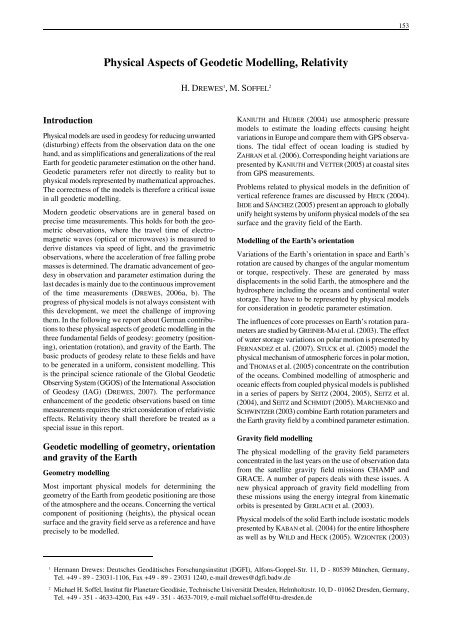NATIONAL REPORT OF THE FEDERAL REPUBLIC OF ... - IAG Office
NATIONAL REPORT OF THE FEDERAL REPUBLIC OF ... - IAG Office
NATIONAL REPORT OF THE FEDERAL REPUBLIC OF ... - IAG Office
You also want an ePaper? Increase the reach of your titles
YUMPU automatically turns print PDFs into web optimized ePapers that Google loves.
Introduction<br />
Physical Aspects of Geodetic Modelling, Relativity<br />
Physical models are used in geodesy for reducing unwanted<br />
(disturbing) effects from the observation data on the one<br />
hand, and as simplifications and generalizations of the real<br />
Earth for geodetic parameter estimation on the other hand.<br />
Geodetic parameters refer not directly to reality but to<br />
physical models represented by mathematical approaches.<br />
The correctness of the models is therefore a critical issue<br />
in all geodetic modelling.<br />
Modern geodetic observations are in general based on<br />
precise time measurements. This holds for both the geometric<br />
observations, where the travel time of electromagnetic<br />
waves (optical or microwaves) is measured to<br />
derive distances via speed of light, and the gravimetric<br />
observations, where the acceleration of free falling probe<br />
masses is determined. The dramatic advancement of geodesy<br />
in observation and parameter estimation during the<br />
last decades is mainly due to the continuous improvement<br />
of the time measurements (DREWES, 2006a, b). The<br />
progress of physical models is not always consistent with<br />
this development, we meet the challenge of improving<br />
them. In the following we report about German contributions<br />
to these physical aspects of geodetic modelling in the<br />
three fundamental fields of geodesy: geometry (positioning),<br />
orientation (rotation), and gravity of the Earth. The<br />
basic products of geodesy relate to these fields and have<br />
to be generated in a uniform, consistent modelling. This<br />
is the principal science rationale of the Global Geodetic<br />
Observing System (GGOS) of the International Association<br />
of Geodesy (<strong>IAG</strong>) (DREWES, 2007). The performance<br />
enhancement of the geodetic observations based on time<br />
measurements requires the strict consideration of relativistic<br />
effects. Relativity theory shall therefore be treated as a<br />
special issue in this report.<br />
Geodetic modelling of geometry, orientation<br />
and gravity of the Earth<br />
Geometry modelling<br />
Most important physical models for determining the<br />
geometry of the Earth from geodetic positioning are those<br />
of the atmosphere and the oceans. Concerning the vertical<br />
component of positioning (heights), the physical ocean<br />
surface and the gravity field serve as a reference and have<br />
precisely to be modelled.<br />
H. DREWES 1 , M. S<strong>OF</strong>FEL 2<br />
1 Hermann Drewes: Deutsches Geodätisches Forschungsinstitut (DGFI), Alfons-Goppel-Str. 11, D - 80539 München, Germany,<br />
Tel. +49 - 89 - 23031-1106, Fax +49 - 89 - 23031 1240, e-mail drewes@dgfi.badw.de<br />
2 Michael H. Soffel, Institut für Planetare Geodäsie, Technische Universität Dresden, Helmholtzstr. 10, D - 01062 Dresden, Germany,<br />
Tel. +49 - 351 - 4633-4200, Fax +49 - 351 - 4633-7019, e-mail michael.soffel@tu-dresden.de<br />
153<br />
KANIUTH and HUBER (2004) use atmospheric pressure<br />
models to estimate the loading effects causing height<br />
variations in Europe and compare them with GPS observations.<br />
The tidal effect of ocean loading is studied by<br />
ZAHRAN et al. (2006). Corresponding height variations are<br />
presented by KANIUTH and VETTER (2005) at coastal sites<br />
from GPS measurements.<br />
Problems related to physical models in the definition of<br />
vertical reference frames are discussed by HECK (2004).<br />
IHDE and SÁNCHEZ (2005) present an approach to globally<br />
unify height systems by uniform physical models of the sea<br />
surface and the gravity field of the Earth.<br />
Modelling of the Earth’s orientation<br />
Variations of the Earth’s orientation in space and Earth’s<br />
rotation are caused by changes of the angular momentum<br />
or torque, respectively. These are generated by mass<br />
displacements in the solid Earth, the atmosphere and the<br />
hydrosphere including the oceans and continental water<br />
storage. They have to be represented by physical models<br />
for consideration in geodetic parameter estimation.<br />
The influences of core processes on Earth’s rotation parameters<br />
are studied by GREINER-MAI et al. (2003). The effect<br />
of water storage variations on polar motion is presented by<br />
FERNANDEZ et al. (2007). STUCK et al. (2005) model the<br />
physical mechanism of atmospheric forces in polar motion,<br />
and THOMAS et al. (2005) concentrate on the contribution<br />
of the oceans. Combined modelling of atmospheric and<br />
oceanic effects from coupled physical models is published<br />
in a series of papers by SEITZ (2004, 2005), SEITZ et al.<br />
(2004), and SEITZ and SCHMIDT (2005). MARCHENKO and<br />
SCHWINTZER (2003) combine Earth rotation parameters and<br />
the Earth gravity field by a combined parameter estimation.<br />
Gravity field modelling<br />
The physical modelling of the gravity field parameters<br />
concentrated in the last years on the use of observation data<br />
from the satellite gravity field missions CHAMP and<br />
GRACE. A number of papers deals with these issues. A<br />
new physical approach of gravity field modelling from<br />
these missions using the energy integral from kinematic<br />
orbits is presented by GERLACH et al. (2003).<br />
Physical models of the solid Earth include isostatic models<br />
presented by KABAN et al. (2004) for the entire lithosphere<br />
as well as by WILD and HECK (2005). WZIONTEK (2003)











